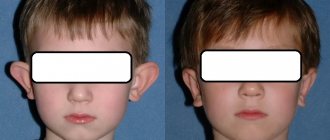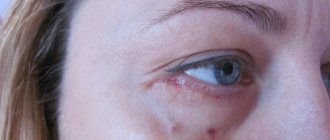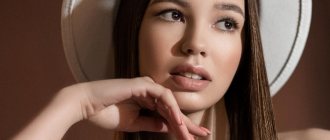Rhinoplasty is a surgical intervention aimed at correcting the appearance of the nose, as well as eliminating discomfort due to difficulty in nasal breathing. It is carried out for aesthetic reasons when the patient is not satisfied with the shape of his own nose, and for medical reasons - for a deviated nasal septum or nasal fractures.
Rhinoplasty is one of the most popular plastic surgeries. However, it is also one of the most difficult due to the structural features of the nose, the difficulty of surgical access, and the limited area of the operation. Of course, the experience and qualifications of the operating surgeon are very important, but successful recovery and satisfaction with the result largely depend on the patient’s compliance with the recommendations during the rehabilitation period.
Stages of recovery after rhinoplasty
Rhinoplasty requires a long rehabilitation period. In most cases, it takes at least 6 months, sometimes this period extends to a year. The patient will be able to return to normal life with some restrictions approximately a month after the operation, but the final results will not be visible soon.
Immediately after surgery
The operation lasts 2-3 hours and is most often performed under general anesthesia. After the patient comes to his senses, he will be able to eat and perform hygiene procedures. Nasal tamponade is not always performed. Nasal breathing can be slightly hampered by splints in the nasal cavity, which maintain its shape and stop bleeding. A plaster splint is placed on top of the nose. It is possible, but not necessary, for hematomas to appear in the nose area and around the eyes. The patient spends 1 to 3 days in the hospital.
First early stage
Primary recovery after rhinoplasty lasts up to 7 days. During this period, swelling is most pronounced, which can spread to the cheeks and lower part of the face. During the week, it is recommended to maintain maximum rest and avoid physical activity. The patient must take medications prescribed by the doctor, treat postoperative sutures, and rinse the nasal cavity to prevent the formation of mucus and crusts.
Second early stage
Lasts from 7 to 14 days. Most often, a week after the operation, a follow-up examination is scheduled, during which the patient will have the plaster cast and splints removed, and the sutures will be removed. The doctor will assess the condition of the nose and give recommendations for further rehabilitation. During this period, severe swelling of the face subsides, bruises, if any, disappear. Swelling may persist on the back of the nose, tip, and lateral surfaces. In general, health improves and the patient can return to normal life.
Third stage
The period is from 2 weeks to 1 month after surgery. The shape of the nose is gradually improving (however, it is still far from ideal), all signs of surgical intervention disappear on the face, the seams fade and become less noticeable. During this period, physiotherapeutic procedures are recommended so that new structures in the nose are formed strong and resistant to external influences.
Between the third stage and the late recovery period, a gradual process of scarring occurs. External changes at this time are hardly noticeable.
Late recovery stage
In the period from 6 months to 1 year, the nose acquires the ideal shape for which the operation was performed. The scars become almost invisible. The patient completely returns to the usual rhythm of life, stress, and all restrictions are removed after rhinoplasty. You can perform cosmetic procedures in the nose area.
Rhinoplasty: answering questions
Rhinoplasty is one of the most popular plastic surgeries. And one of the first in terms of the number of questions asked. We have collected questions for the week from the social networks of plastic surgeons at the GALAXY Beauty Institute and are sharing with you the answers of our doctors.
How long does swelling last after rhinoplasty?
Everything is individual. Noticeable swelling and bruising disappear within 2-3 weeks. To speed up the rehabilitation process, the GALAXY Beauty Institute offers three free procedures or a paid extended rehabilitation course. (Staisupov V.Yu.)
How to care for your nose after surgery?
Surgeon E.A. Siverina recommends rinsing your nose with saline solution. Each nostril is irrigated separately, the second at this moment is slightly covered with the thumb, the wing of the nose cannot be pressed. The remains of the drug are blown out with an open mouth. The procedure is repeated at least three times a day for 3-4 weeks. To soften the mucous membrane and prevent the formation of crusts after treatment, peach oil is instilled into the nose. If correction of the nasal septum was performed simultaneously with rhinoplasty, rinsing is not performed.
Will the bridge of the nose become wider if the hump is removed?
No, the back width will remain the same because the bones move after the hump is removed. (Staisupov V.Yu.)
Can rhinoplasty be done before the age of 18?
At the GALAXY Beauty Institute, plastic surgery is performed only on adult patients. However, for medical reasons, rhinoplasty can be performed up to 18 years of age. (Staisupov V.Yu.)
Are there any restrictions for ladies over 60?
If the condition of the body allows for surgery, rhinoplasty is not contraindicated. Rehabilitation may take longer because tissues heal less well at this age. (Staisupov V.Yu.)
Is it possible to get your nose pierced after rhinoplasty?
Yes, you can. (Staisupov V.Yu.)
Do I need to wear compression stockings during rhinoplasty and why?
The nose and stockings are not directly related. During the operation, you will spend some time without moving under anesthesia. For diseases of the veins of the lower extremities, in particular varicose veins, thromboembolism prevention is required. If you need such stockings, the GALAXY Beauty Institute will provide them. (Staisupov V.Yu.)
Can I take vitamin C before and after rhinoplasty?
Yes, you can. (Staisupov V.Yu.)
What anesthesia is used for rhinoplasty?
We perform rhinoplasty only under anesthesia (general anesthesia) in order to minimize all discomfort for the patient. (Staisupov V.Yu.)
Is it true that during rhinoplasty the bone in the hump area is broken?
To get rid of the hump, we use an osteotome - a tool for carefully cutting cartilage and bone. (Staisupov V.Yu.)
How long does the operation take?
On average 1.5-2 hours, depending on the complexity of the plastic surgery. We try to avoid unforeseen situations and uncertainty; if necessary, we prescribe additional examinations so that the operation plan does not change during the intervention. (Staisupov V.Yu.)
How long after rhinoplasty can I clean my face (including my nose)?
Ultrasonic cleaning is allowed after 3 weeks, mechanical cleaning - no earlier than after 2 months. (Siverina E.A.)
How will my rehabilitation proceed if I am from another city?
On the first day you will be in the clinic. The cost of a day in the ward is included in the cost of the operation. You need to stay in St. Petersburg for 7-10 days. At first there is a risk of bleeding, sometimes quite severe. In addition, it is better for the attending physician to remove the plaster cast. Removal occurs on 7-10 days. After this you can go home. If the tissue is healing normally, follow-up examinations will be required at 3, 6 and 12 months. At other times, consultations are possible via messengers or Instagram. (Siverina E.A., Staisupov V.Yu.)
Is it possible to correct only the tip of the nose?
Theoretically, yes, if you really only need to fix the tip of the nose. This happens rarely. If the bridge of the nose is wide or there is a hump, limited plastic surgery will make them more massive. Harmony and correct proportions are important. (Siverina E.A.)
How can you see the result of rhinoplasty before surgery?
If desired, we carry out computer modeling, where we correct the nose in the photo according to your wishes. The simulation result is approximate and does not always coincide 100% with the outcome of the operation. (Siverina E.A.)
Will the tip of the nose droop after rhinoplasty?
Over the years, the tip drops a little, just like a nose without plastic surgery. (Safonova L.N.)
How many days does your nose hurt after surgery?
Most patients experience no pain, only discomfort from nasal congestion. (Moshkalova A.L.)
Is it possible to have a nose job during your period?
Blood loss during the operation is insignificant, but rhinoplasty is not performed in the first 3 days of menstruation. (Siverina E.A.)
Will I have problems with passport control after rhinoplasty?
Yes, problems may arise if the shape of the nose is adjusted significantly. It is better to take with you a certificate of the intervention performed or make a passport with a new photo. (Siverina E.A.)
Do enlarged pores remain on the nose after surgery?
Plastic surgery does not affect the structure of the skin of the nose. Cosmetologists will help you get rid of enlarged pores. (Cohen I.A.)
What are the contraindications for rhinoplasty?
A healthy person does not have them. In general, the list is the same for all plastic surgeries. (Cohen A.N.)
How long after a nose job can you kiss?
In 2-3 weeks. If you touch your nose before it heals, it will be very painful. (Staisupov V.Yu.)
Where does excess skin from the tip go when the nose is shortened?
It all depends on the thickness of the skin and the degree of shortening. The skin contracts. In some cases, excess skin is removed by a surgeon. (Staisupov V.Yu.)
What massage do you recommend after nose job?
It is better to refrain from massaging the nose after rhinoplasty so as not to displace its structures. (Staisupov V.Yu.)
Is it possible to have a nose job in winter?
Yes, you can. The operation is carried out year-round. (Staisupov V.Yu.)
How long after a nose job can I go to the solarium?
Not earlier than 5 weeks after surgery. Ultraviolet irradiation and heat dilate blood vessels and can cause bleeding. (Staisupov V.Yu.)
Is thrombophilia a contraindication for rhinoplasty?
Rhinoplasty can be performed for thrombophilia if blood test results are good and only with the permission of a hematologist. (Staisupov V.Yu.)
How much time should pass between rhinoseptoplasty and installation of braces?
The operation can be done even the next day if we are talking about standard bite correction. In case of severe disorders, consultation with an oral and maxillofacial surgeon may be required. (Staisupov V.Yu.)
If adhesions form in the nose after surgery, can you see them yourself?
It is very difficult to see adhesions on your own; if you are worried, consult an ENT specialist. (Staisupov V.Yu.)
What medications are contraindicated before rhinoplasty? Can I take antiviral medications?
Any medications are allowed, except blood thinners (aspirin and its analogues). (Staisupov V.Yu.)
How long after catching a cold and taking antibiotics can I get a nose job?
It takes 10-14 days for the body to recover. After this, the operation is allowed. (Staisupov V.Yu.)
Is it possible to have rhinoplasty in summer? If yes, what precautions should be taken?
The operation is carried out at any time of the year. In the summer, you need to protect your face from the sun: use protective creams and wear a hat. Excessive heat to the skin and ultraviolet light can cause bleeding. (Staisupov V.Yu.)
Is it possible to do rhinoplasty during the healing stage of dental implants?
Yes, it is allowed. (Staisupov V.Yu.)
Is it true that you can’t get pregnant for a year after rhinoplasty? Why?
It is better to refrain from pregnancy for six months to a year after surgery. Bearing a child is a serious process, accompanied by changes in hormonal levels and water-salt metabolism. Many women experience swelling. Rhinoplasty will not affect the pregnancy itself, but the result of plastic surgery may become slightly worse. (Staisupov V.Yu.)
Nutrition after rhinoplasty
After plastic surgery on the nose, you should adhere to some dietary restrictions. An important condition for rapid healing is facial rest, so you need to minimize the work of the masticatory muscles. In the first 1-2 weeks after surgery, preference should be given to liquid and semi-liquid foods, which should not be hot. You cannot drink hot tea, coffee, or too cold drinks. It is necessary to reduce the consumption of salt, smoked foods, hot and spicy foods, which retain water in the body and contribute to the appearance of edema.
Early recovery period
The first two weeks after surgery are the most difficult from a physical and psychological point of view. The patient spends them at home, under the supervision of a loved one or family members. In order for the body to recover faster, you need complete rest, both mental and physical.
In the first 2-3 days after rhinoplasty, the areas of the nose, lower and upper eyelids, cheekbones and cheeks become very swollen. Swelling increases and is accompanied by the formation of internal bruises, or hematomas. It is possible to increase body temperature to 37.5-38°. There is minor pain that can be relieved with painkillers. This condition is normal and should not be scary: active tissue regeneration is underway.
It is better to prepare yourself in advance for the fact that during the first postoperative weeks the reflection in the mirror will not please you. The main thing is to remain calm and in a good mood, and even more important, not to violate any of the plastic surgeon’s recommendations.
Facial care is complicated by the fact that the nasal passages are closed with cotton swabs (only in the first 1-2 days), and a bandage is applied to the face (removed after 7-10 days). If manipulations were carried out on the cartilaginous or bone part of the septum, special silicone plates - splints - can be used. All this helps reduce nosebleeds and fix the tissues changed by the surgeon.
Until the doctor removes the turundas, I can only breathe through my mouth. This causes discomfort, especially during night sleep, and leads to dry lips and oral mucosa. To reduce discomfort, you can drink water with lemon juice. It is recommended to apply a protective balm to the lips. Splints allow you to breathe through your nose; they are removed a few days after rhinoplasty.
To protect the nose from accidental mechanical impact and ensure reliable fixation, a plaster cast or a special lining made of medical plastic is used. Do not touch or wet the fixing bandage. Only the attending physician can remove it.
In the first days, there may be discharge from the nasal cavity mixed with blood, a feeling of numbness in the area of the upper lip and nose. These are consequences of surgery that should not be frightened. The sensitivity of the integumentary tissues will be completely restored in a few months. The mucous bleeding will stop within a few days. The reason to immediately consult a doctor is heavy bleeding.
Recommendations for successful recovery
What to do after rhinoplasty:
- follow all doctor’s advice and prescriptions;
- sleep on your back with the head of the bed raised or on a high pillow;
- exclude significant physical activity for 2-3 months;
- follow a diet;
- do not use active facial expressions;
- sneeze with your mouth closed.
What not to do during the rehabilitation period:
- To wear glasses;
- sleep on your side, stomach;
- lift weights;
- play sports with significant loads;
- blow your nose with force;
- take a hot bath, visit a bathhouse, sauna, solarium.
What is rhinoseptoplasty?
Classic rhinoplasty corrects only aesthetic defects of the nose. These include:
- hump,
- voluminous or small tip,
- too narrow or wide wings,
- asymmetry and much more.
Unlike rhinoplasty, septoplasty is an operation that is performed for medical, not aesthetic reasons. During septoplasty, a deformed nasal septum is corrected. The septum is deviated as a result of injury or disease, or is a congenital defect. A deviated septum causes breathing difficulties and related problems - snoring, lack of oxygen supply, headaches, constant runny nose, etc.
In plastic surgery, rhinoseptoplasty is a combination of aesthetic and functional rhinoplasty. During the operation, the doctor corrects the septal defect and also models the harmonious features of the nose, eliminating visual imperfections.
How to speed up rehabilitation?
To ensure that recovery after rhinoseptoplasty occurs as quickly and efficiently as possible, it is first of all important to follow all the instructions of the plastic surgeon. At this time, everything depends only on the behavior of the patient himself. If the operation was carried out brilliantly, but the patient violated the rules of rehabilitation, the final result may differ from what was planned, not for the better.
Various methods are used to help tissue heal faster. Various drugs that have anti-edematous and anti-inflammatory effects can help - for example, Traumeel. Some physical procedures are also effective. It is important to understand that self-prescribing medications or procedures is strictly prohibited. Any actions must be previously agreed with the plastic surgeon. You should only use medications or attend physical therapy with your doctor's approval.
Operation
Surgical rhinoplasty is performed under local or general anesthesia. The choice of pain relief method depends on the extent of the intervention. The decision is made by the surgeon and anesthesiologist.
Most often, rhinoplasty is performed in a closed manner, since it gives a more aesthetic result (all incisions are hidden).
Closed rhinoplasty
The incision is made in the nasal cavity, on the mucous membrane of the nostril, so no traces of surgical intervention remain on the outside.
Through the incision(s) made, the surgeon peels away the skin from the cartilage and bones of the nose. Then he carries out the planned correction on the osteochondral frame of the nose, removing excess, or changing the shape, increasing the volume with cartilage taken from another place in the patient, or restoring lost tissue with an endoprosthesis. The skin returned to its place takes root, gradually taking on a new shape of the nose.
Open rhinoplasty
Incisions are made in the nasal cavity along the edge of the nostrils (as with a closed approach), as well as in the lower part of the nose along the columella - the skin part of the septum between the nostrils. Then everything happens in the same way as during a closed operation - peeling of the skin and corrective actions by the surgeon.
With open access, any parts of the nose can be corrected, so if more massive interventions are needed, as well as for revision rhinoplasty, this access is used. The suture after the operation is almost invisible. However, recovery time and the risk of postoperative complications are slightly higher with the open approach.
The duration of the operation is usually 1-2 hours, depending on its complexity.
Contraindications for rhinoplasty
- Age under 18 years. The exception is injury. Then nose surgery is possible with the written consent of the parents
- Age over 40 years. The reason is a decrease in skin elasticity, regenerative abilities, increased risk of complications
- Decompensated diseases of the heart and blood vessels (ischemic heart disease, heart failure, hypertension), liver and kidneys
- Diabetes
- Oncological pathology
- Acute viral infections
- Mental illness
- Inflammatory skin diseases in the area of the planned operation (acne, etc.)
- Bleeding disorders
First days
During the day after surgery, the patient must remain in the hospital hospital under the supervision of medical personnel. If the patient feels well, he is discharged from the clinic the next day.
If the patient has no complaints about his health, he can return home the very next day after the operation.
After the operation, the patient is inserted into the nasal passages with silicone splints and a plaster bandage is applied to the face. Unlike turundas, splints have channels for breathing, so the breathing process should not be difficult.
The plaster cast and splints cannot be removed independently. The bandage should also not be moved from its place. The removal of these things is carried out by a surgeon. On average, splints are removed after 5-10 days, the bandage is removed 7-15 days after the intervention.
Breathing after nose surgery from Andrey Ross.
Andrey Ross does not use gauze swabs during the recovery period after rhinoplasty. Instead, the patient is given special silicone tubes called splints. (Link to video about splints). They can be double or separate, but the most important thing is that with their help the patient can breathe. They are removed completely painlessly the next morning after rhinoplasty.
Sign up for a free consultation
Rhinoplasty comes in different forms. Primary, repeated, closed, open. It can be divided into types of impact: tip of the nose, septum, hump, correction of the wings of the nose and many others. And today I will publish a photo of the results of removing the nasal hump. After the operation, the patient’s profile became lighter and more feminine. Just a reminder that you can ask questions about plastic surgery in the comments! #DoctorRoss #Rossmedicalgroup #Rhinoplasty #Plastic nose #Septoplasty #hump #hump nose #plastic #plastic surgeon #plastic surgery clinic
The final result, its preservation and maintenance
The fully formed result of nose surgery will be visible in 6-12 months. At earlier stages of rehabilitation after rhinoplasty, defects (overcorrection or insufficient correction of the nose), if they occurred, become visible. They can be corrected with repeated surgery. According to experts, the probability of revision rhinoplasty is approximately 15%. The result of surgical correction of the shape of the nose, most often, remains forever, less often - unchanged for several decades. You can independently maintain this result in two ways - follow all the doctor’s recommendations for the rehabilitation period and protect your nose and face from injury.
When to have surgery?
For congenital deformities, surgery is best done after 20 years of age, when the formation of the bone and cartilaginous base of the nose is completely completed. The ideal age for surgical correction is from 20 to 35 years, when the osteochondral nasal frame is already fully formed and the skin is still elastic enough to accept and maintain the new corrected shape of the nose.
In any case, the operation is performed no earlier than 18 years, when the formation of the bone structure of the nose is completed.
Acquired nasal deformities leave no choice - surgery is performed when the need arises and the patient’s general condition allows.
4-6 weeks after surgery
At this time, there is a noticeable improvement in aesthetics. Visible swelling goes away, but secondary swelling remains - it lasts longer than the primary one, but is barely noticeable to others. This period is very important for the rehabilitation process and the formation of the highest quality result, since it is at this time that the key processes of healing and regeneration occur.
For 1-1.5 months after the operation, you cannot play sports or undergo thermal procedures - bathhouse, sauna, hot bath. Solariums and the beach are also prohibited. It is undesirable to wear glasses that put stress on the operated area. During recovery, it is better to replace glasses with lenses or not wear them at all. You should be careful when blowing your nose - do not do it forcefully, so as not to damage the nasal tissue and cause bleeding.
Glasses after nose surgery are undesirable; it is better to replace them with lenses.










